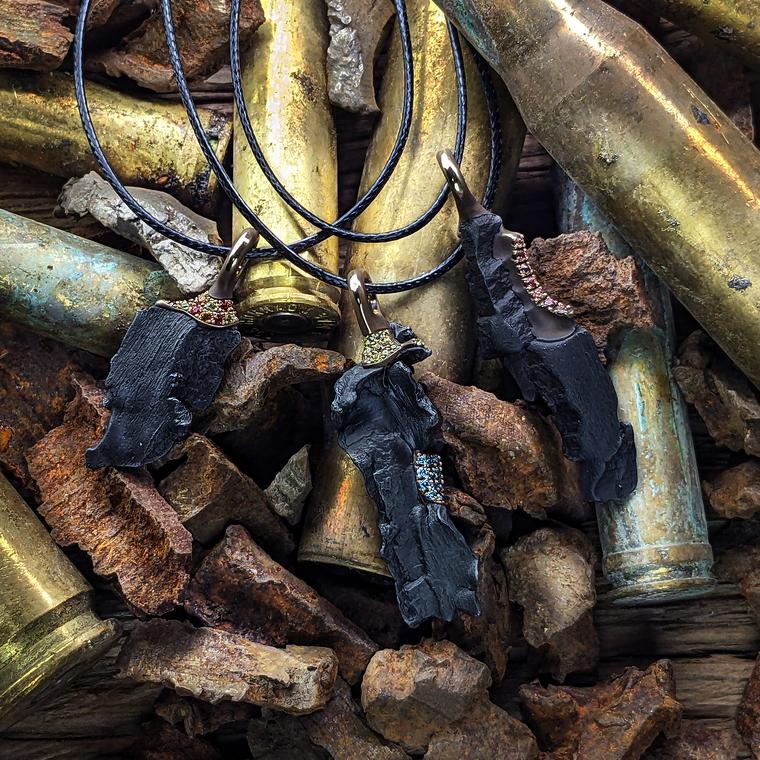“When shells and missiles fly into Kharkiv every day and explode, and residential buildings and schools are destroyed nearby, you don’t know whether you will wake up tomorrow,” says Ukranian jeweller Stanislav Drokin. In such a scenario, “high jewellery and luxury items cease to be valuable,” he notes.
At the outbreak of the war in Ukraine, which will this month mark two years of conflict, Drokin had to make a choice. Stay or leave. He chose to stay on the front line, caring for his elderly mother and volunteering in a military hospital and his workshop became a volunteer warehouse for a hospital. “I also did not want to leave my life’s work - my atelier and my art,” he says.
On the first day of the war, Drokin and his wife Liudmyla left their home and moved into his workshop, along with two other families they were friends with. All of them bar Drokin would eventually leave Kharkiv, including Liudmyla, who now lives with their daughter in Germany. The jeweller remained in the war-torn Kharkiv city and in the region, 2,355 civilians, including 79 children, have lost their lives since the start of the war. And in the rubble, he has found fresh creativity.
“With the outbreak of the war, I could not engage in creative work in the same way as before,” says Drokin, whose experimental, colourful luxury jewellery has won numerous international awards during his three-decade career. “At the same time, Ukrainian consumers’ priorities and values changed, and interest in investing in high jewellery dropped. For me, the greater value was the shift in focus to the idea, the social message of the author, rather than the use of gold. So my focus shifted from gold to bronze, titanium and steel; [materials that are] more suitable for art for the current time.”

The use of non-precious materials is not new to Drokin. The largely self-taught jeweller first found his passion while working at a radio electronics factory, where he learned engraving and metalworks, and his is known for complex casting techniques that fuse high and low materials. What is new is the source: Drokin risks his life by heading out into the streets of Kharkiv to collect steel shell fragments from spent ammunition.
“In front-line Kharkiv, there were enough fragments from shells, and I decided to use this material in my creative work,” says Drokin, who first turned the shards into Forget-Me-Not brooches by adding blued-titanium blooms to the jagged metal pieces. “[It is] a socio-cultural international project, which through the pieces of the collection preserves the memory of the events of each day of Russia's war against Ukraine, the memory of the courage of its defenders. It is also a symbol of gratitude for international legal, humanitarian, medical and military assistance, which contributes to the victory of Ukraine, and a symbol of the revival of life on the ruins of the tragedy.”

The Forget-Me-Knot brooches are not for sale but are created by Drokin as gifts for those who have helped Ukrainians. One did make it to auction, selling for CHF12,600 at Sotheby’s Geneva in November. All the profits were donated to Ukrainian prosthetics charity Superhumans, which helps victims of the war who have lost limbs.
Drokin has also used shell fragments in his Revival collection of pendants. The shards, left in the form he finds them in, are darkly beautiful, accented with clusters of melee gems – richly hued sapphires, blue diamonds – set in bronze. The application of the bronze to the steel calls for a special casting technique Drokin developed called Fercupium, during which he pours molten bronze onto these remnants of war to create a unified piece of mixed metal. He describes it as being similar to the Indian metalsmithing method of Ganga-Jamuna that fuses brass and copper.
Another of Drokin’s casting techniques, Feraurium, fuses steel fragments of projectiles to 18ct yellow gold. Through this, he has used war waste to create bezels for cocktail rings. The rough metal loops around classic central stones, such as faceted citrines and tourmalines, creating a stark contrast or calm and chaos.
The Revival pendants will soon be sold through Article22, a New York-based jewellery company known for its work with artisans in Laos who create jewels made from shrapnel left by America’s intense bombardment of the country between 1964 and 1973. During that time, 250 million bombs were dropped on Laos, with 80 million unexploded, leaving a dangerous legacy that haunts its people to this day. As well as clearing up the debris, Article22’s mission is to clear unexploded bombs, donating money from the sales to the Mines Advisory Group (MAG) to fund this work. Drokin says that the sale of his Revival collection – which he was inspired to develop after Article22 founder Elizabeth Suda reached out to him – will fund similar MAG projects in Ukraine.

Drokin has found a sharp new creativity and purpose amongst the devastation of his city and his life. He longs to return to the high jewellery of his peacetime past that is art for art’s sake, but while the war still rages he remains committed to using his talents to ensure the world does not forget about Ukraine.

















